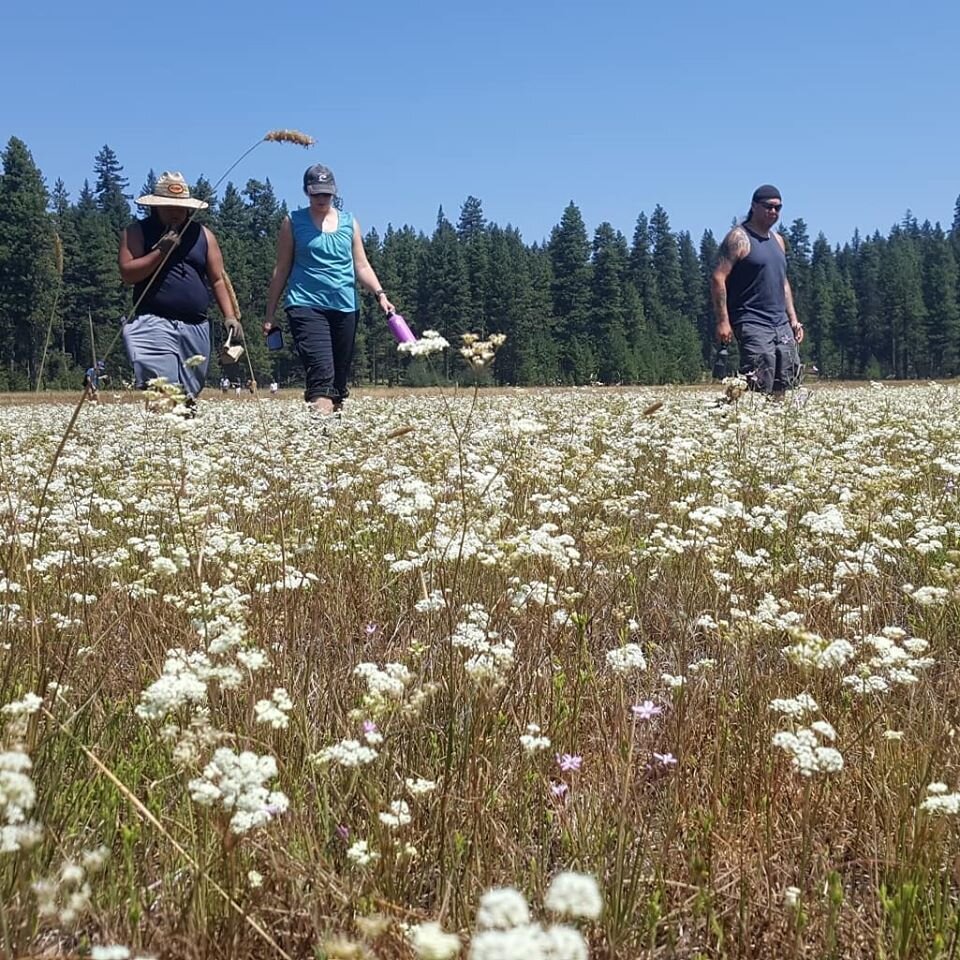Restoration of First Foods
Camas lily fruits
by Nora Seymour
Vesper Meadow Education Program Intern 2020
The last of the Camas lily, Cammasia quamas flowers are blooming across the wet meadows at Vesper Meadow. Most of the plants have transitioned to fruit and soon we will begin to harvest seeds from them. Come fall we will be able to plant these seeds in other places that have been degraded over the last two centuries and increase the population of this important Native food plant at Vesper Meadow.
Camas lily is a perennial plant in the American West, ranging from the Sierra Nevada Mountains to southern British Columbia. The underground bulb and leaves grow for multiple years before producing purple, or occasionally white, compound flowers comprised of multiple florets. Characteristic of lilies, It has long, smooth, grass-like leaves with parallel veins, and the six-petaled flower grows on its own taller stem. From May to June, flowers form small buds before blooming into florets. From June to July the flowers turn to fruits and produce black seeds.
The underground bulbs of camas are a high calorie staple food item for many tribes in the Pacific Northwest. These bulbs are harvested with digging sticks in mid summer to fall, cooked for long enough to process and break down a un-digestible sugar called inulin, and stored for winter. Camas is often made into dough and cakes, which store well.
Vesper Meadow was an important summer hunting and plant cultivation site location for the Latgawa tribe, as well as potentially the Takelma and Shasta, and camas was one of the most important plants cultivated here as an “Indigenous Garden.” Although we often hear the terms foraging or gathering used for indigenous food practices, many plants, including camas, are significantly managed in an agricultural way. The digging of camas helps to loosen soil for better growing conditions. Bulbs are selectively harvested, leaving behind smaller bulbs to keep growing. Fire is used to clear away undesirable plants and allow light and warmth to encourage vigorous camas growth. Enough plants are always left for seed, and seeds are spread after autumn meadow burns.
During the time of genocide of Native people in Southwest Oregon in 1850’s, Latgawa, Takelma, and Shasta people were forcefully removed from this area, and moved to the Siletz or Grand Ronde reservations farther north in Oregon. This land then saw a drastic change in use and management, and the camas, and other native plants, have suffered because of it. A combination of cattle grazing, introduction of non-native grasses, water diversions for irrigation, and lack of tending by humans has led to camas populations decreasing. At Vesper Meadow the camas is still abundant even after generations of cattle grazing, thanks to thousands of years of human tending, but is threatened by other plant species, changing water patterns, and climate change.
Camas lily is a primary focus for restoration at Vesper Meadow and we are monitoring current populations. We are setting up experimental plots, collecting baseline information, and testing multiple restoration techniques. These techniques concentrate on removing non-native grasses that smother native plants like camas. One big restoration project already underway, is the tarping of a 1500 square foot area of nonnative grass, which will heat up throughout the summer season - effectively baking the nonnative grass. In the fall the tarps will be removed and the area will be seeded with camas and other native plants. Other projects include seasonal burning, and transplanting of camas plants.
Tarp restoration project with volunteers and staff from The Understory Initiative.
Siletz Tribe members walk amongst Yampah at Vesper Meadow July 2019.
In addition to ecological restoration, Vesper Meadow aims for cultural restoration as well. Vesper Meadow Education Program is building relationships with members of the Siletz tribe whose ancestors called this land home, and has been honored by their visits to harvest food crops, such as Yampah. Along with the restoration of camas, we are working to support an Indigenous-led coalition that will ultimately increase access to First Foods at Vesper Meadow and across Southwest Oregon. Soon, these plants will again be harvested and tended by the people who have held a long time relationship with them.





